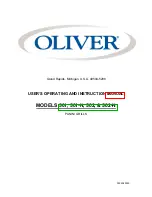
14
Operating Instructions (Continued)
Cleaning and Care
Important:
Excessive flare-ups result from the build-up of grease in the bottom of your grill .
If a grease fire occurs
, close the lid
AND
turn regulator/control knob to “ OFF,” until the grease burns out . Use caution when opening the lid
as sudden flare-ups may occur .
If excessive flare-ups occur, do
NOT
pour water onto the flames .
Minimize Flare-ups:
1 . Trim excess fat from meats prior to cooking .
2 . Cook high fat content meats on (LOW) setting or indirectly .
3 . Ensure that your grill is on a hard, level, non-combustible surface and the grease is allowed to drain into a grease receptacle .
W
CAUTION:
1. All cleaning and maintenance should be done when grill is cool and
with the fuel supply disconnected.
2. Do NOT clean any grill part in a self-cleaning oven. The extreme heat
will damage the finish.
3. Do NOT enlarge valve orifices or burner ports when cleaning the
valves or burners.
Notices
1. This grill should be thoroughly cleaned and inspected on a regular basis.
2. Abrasive cleaners will damage this product.
3. Never use oven cleaner to clean any part of grill.
Before Each Use
1 . Keep the grill area clean and free from any combustible materials, gasoline, and other
flammable vapors and liquids .
2 . Do NOT obstruct the flow of the combustion of LP gas and the ventilation of air .
3 . Keep the ventilation opening(s) of the LP gas tank area free and clear from debris .
4 . Visually check the burner flames to make sure your grill is working properly (Figure 8) .
5 . See below for proper cleaning instructions .
6 . Check for obstructions of airflow to the burners . Spiders, insects and webs can clog the
burner/venturi tube . A clogged burner/venturi tube can lead to a fire .
Cleaning Surfaces
1 . Wipe surfaces clean with mild dishwashing detergent or baking soda mixed with water .
2 . For stubborn surfaces, use a citrus-based degreaser and a nylon scrubbing brush .
3 . Rinse clean with water .
4 . Allow to air dry .
Cleaning Main Burners
1 . Turn regulator/control knob to “ OFF .”
Note: A “poof” sound is normal as the last of the LP gas is burned .
2 . Disconnect LP gas tank per “Disconnecting LP Gas Tank” section .
3 . Remove regulator/control knob and wind guard .
4 . Remove cooking grid and heat plate .
5 . Disconnect wire from igniter, if applicable .
6 . Remove burner .
7 . Remove all food residue and dirt from burner surface .
8 . Disconnect wire from spark electrode .
9 . Clean inlet of burner with small bottle brush or compressed air .
Figure 8
Burner Flame Conditions
Use this chart to see if your burners
need to be cleaned .
1-2 in. /
25.4 - 50.8 mm
Normal:
Soft blue flames with yellow
tips between 1 in . - 2 in . height .
Needs cleaning:
Noisy with hard
blue flames .
Has to be replaced:
Wavy with
yellow flames .















































